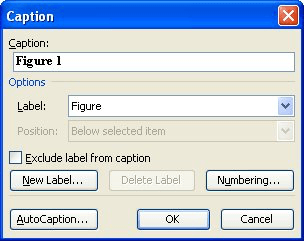Please Note: This article is written for users of the following Microsoft Word versions: 97, 2000, 2002, and 2003. If you are using a later version (Word 2007 or later), this tip may not work for you. For a version of this tip written specifically for later versions of Word, click here: Adding Captions.
Written by Allen Wyatt (last updated January 6, 2018)
This tip applies to Word 97, 2000, 2002, and 2003
Captions are normally included as a design element of a document. For instance, your design may dictate that every table needs to include a caption that identifies the table. There are two ways you can add a caption in your document. The first is to create your own, and the second is have Word add the caption for you.
If you want to add your own caption, simply start a new paragraph and type the caption. Then make sure that the paragraph is formatted with the Caption style.
If you want to instruct Word to add the caption, follow these steps:

Figure 1. The Caption dialog box.
Since there are multiple steps to insert a caption in this fashion, you may wonder why anyone would use Word to add the caption. There are a couple of reasons. First of all, when Word inserts the caption there is a certain amount of uniformity that is used. You can specify the same label to appear at the beginning of each of your captions. Second, the number that is added to the caption is created as a sequence field. This means that even if you later move the caption, the numbering of the caption will be automatically updated and corrected by Word. Finally, if you aren't comfortable working with styles, using Word to add the caption precludes you from the necessity of assigning styles.
WordTips is your source for cost-effective Microsoft Word training. (Microsoft Word is the most popular word processing software in the world.) This tip (890) applies to Microsoft Word 97, 2000, 2002, and 2003. You can find a version of this tip for the ribbon interface of Word (Word 2007 and later) here: Adding Captions.

Do More in Less Time! An easy-to-understand guide to the more advanced features available in the Microsoft 365 version of Word. Enhance the quality of your documents and boost productivity in any field with this in-depth resource. Complete your Word-related tasks more efficiently as you unlock lesser-known tools and learn to quickly access the features you need. Check out Microsoft 365 Word For Professionals For Dummies today!
When you add captions to elements in your document, Word allows you to modify how those captions are formatted. Here's ...
Discover MoreDefine a label to be used in a caption, and you may later want to delete that label. Here's how you can easily make the ...
Discover MoreUsing Word's captioning feature can be a great boon for automatically numbering certain elements in your documents. It ...
Discover MoreFREE SERVICE: Get tips like this every week in WordTips, a free productivity newsletter. Enter your address and click "Subscribe."
There are currently no comments for this tip. (Be the first to leave your comment—just use the simple form above!)
Got a version of Word that uses the menu interface (Word 97, Word 2000, Word 2002, or Word 2003)? This site is for you! If you use a later version of Word, visit our WordTips site focusing on the ribbon interface.
Visit the WordTips channel on YouTube
FREE SERVICE: Get tips like this every week in WordTips, a free productivity newsletter. Enter your address and click "Subscribe."
Copyright © 2026 Sharon Parq Associates, Inc.
Comments